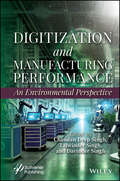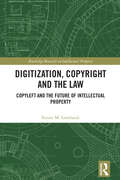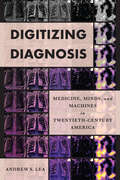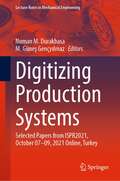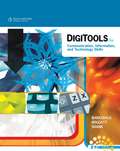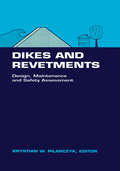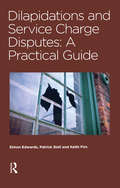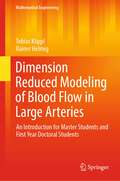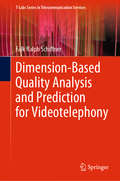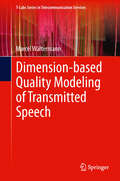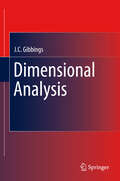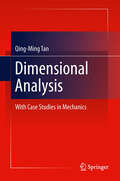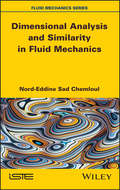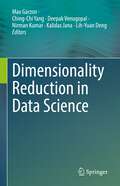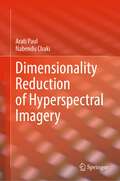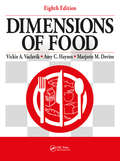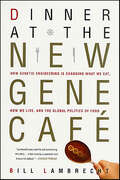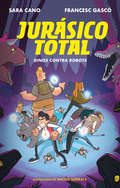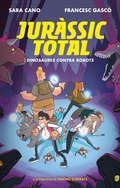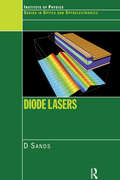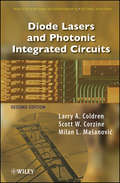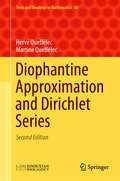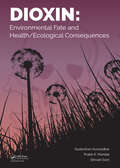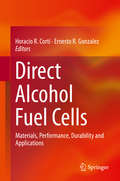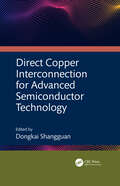- Table View
- List View
Digitization and Manufacturing Performance: An Environmental Perspective
by Chandan Deep Singh Davinder Singh Talwinder SinghThe book provides valuable insights into how modern production strategies can enhance quality, efficiency, and environmental sustainability, ultimately driving profit and competitive advantage in today’s high-tech industry. Today, production strategies are influenced by quality, cost, delivery, innovation, and responsiveness. Firms have traditionally pursued these goals through the adoption of production practices, such as simultaneous engineering, increasing efficiency through the elimination of defects, setup reduction, and worker empowerment. However, recent developments in industry suggest that industry regulators and professional bodies must encourage innovation in a broad range of high-tech production facilities with the environment in mind. The success of the industry depends on production facilities and the competitive advantage that the industry gains due to better quality and reliability. This advantage leads to an increase in sales and the creation of a sound customer base for greater market share, which eventually leads to more profit, growth, and expansion. A firm’s processes must possess operating advantages in the form of competitive priorities to outperform its competitors, keeping in mind its influence on the environment. Digitization and Manufacturing Performance: An Environmental Perspective presents the expectations of industrialists, policymakers, and academics by evaluating the impact of production facilities. Readers will find the book: Discusses emerging technologies and their role in environmental aspects in detail; Provides a comprehensive overview of the latest existing and emerging technologies and their environmental aspects; Justifies social, economic, and technical considerations of these technologies; Explores the relationship between advanced technologies and the environment through in-depth studies. Audience Researchers, scholars, faculty, professionals in research and development, and industrialists in the industrial, production, mechanical, and electronics sectors.
Digitization, Copyright and the Law: Copyleft and the Future of Intellectual Property (Routledge Research in Intellectual Property)
by Ettore M. LombardiThis book discusses copyleft and its impact on the traditional way to conceive of property. It is specifically focused on the European and international juridical framework.Analysing the impact of digitalization on copyright and the potential effect of copyleft in the European market and within a European and international juridical framework, this book explores the complex evolutionary framework which charts the reduction of physical property and the progressive expansion of intangible assets. Although digitalization enables more accessibility than ever before, this impacts traditional intellectual property frameworks. Evaluating common traits of ownership structure, the book considers the challenges that intangible property, open source and creative commons present to the current legal system. Examining the impact of copyleft on copyright and the law of ownership, the book considers the rights of authors and creators, legal limits and complications arising from these new forms of ownership of intangible assets. The book is grounded in the European potential regulatory framework of copyleft through movements like open-source software.The book will be of interest to students, academics and practitioners with an interest in contract law, property law and intellectual property law.
Digitizing Diagnosis: Medicine, Minds, And Machines In Twentieth-century America (Studies In Computing And Culture Ser.)
by Andrew S. LeaDigitizing Production Systems: Selected Papers from ISPR2021, October 07-09, 2021 Online, Turkey (Lecture Notes in Mechanical Engineering)
by Numan M. Durakbasa M. Güneş GençyılmazThis book contains selected papers from International Symposium for Production Research 2021, held on October 7–9, 2021, online, Turkey. The book reports recent advances in production engineering and operations. It explores topics including production research;production management; operations management;industry 4.0;industrial engineering;mechanical engineering;engineering management; andoperational research. Presenting real-life applications, case studies, and mathematical models, this book is of interest to researchers, academics, and practitioners in the field of production and operation engineering. It provides both the results of recent research and practical solutions to real-world problems.
Digitools: Communication, Information, and Technology Skills
by Jack P. Hoggatt Jon A. Shank Karl BarksdaleNo other book better prepares students for the innovations in Microsoft Office (2010 and 2007) and living in today's digital world like the third edition of DIGITOOLS! DIGITOOLS emphasizes computer applications, such as word processing, presentations, spreadsheets, and database while also providing instruction on the proper way to key and format documents using proven instructional methods, Students learn to effectively use the Internet and input technologies, including speech and handwriting recognition.
Dikes and Revetments: Design, Maintenance and Safety Assessment
by Krystian W. PilarczykLow-lying countries, such as the Netherlands, are strongly dependent on good and safe sea defences. In the past, the design of dikes and revetments was mostly based on vague experience, rather than on general valid calculation methods. The demand for reliable design methods for protective structures has, in the Netherlands, resulted in increased research in this field. These contributions have been prepared by Dutch experts participating in the study groups of the Technical Advisory Committee on Water Defences. The book opens with an outline of general strategy and methodology on sea defences, illustrated in the following chapters by technical information on specific items and Dutch experience, and it ends with more general aspects such as probabilistic approach, integral (multifunctional) design, management & safety assessment. Together, these chapters provide an almost complete technical overview of the items needed for the design and maintenance of dikes and revetments. The enclosed CRESS-program allows for an initial estimation of hydraulic loads and preliminary design.
Dilapidations and Service Charge Disputes: A Practical Guide
by Simon Edwards Patrick Stell Keith FirnWritten by three surveyors, each with extensive experience in the sector, Dilapidations and Service Charge Disputes will guide practitioners through the common and new practices involved in dealing with disputes on dilapidations and service charge matters. The book offers practical guidance on the related topics of dilapidations and service charge disputes, bridging the gap between heavy-weight legally focussed case law publications and the lighter weight guidance notes. It offers practical and theoretical advice that will be invaluable to any surveyor or solicitor dealing with: condition reports prior to a lease agreement litigation avoidance advice dilapidations law and precedent. Beneficial to surveyors and solicitors acting on behalf of tenants or landlords, this book provides the information and practical advice that can help you improve in your role.
Dimension Reduced Modeling of Blood Flow in Large Arteries: An Introduction for Master Students and First Year Doctoral Students (Mathematical Engineering)
by Rainer Helmig Tobias KöpplThis monograph contains an in-depth and coherent treatment of dimension-reduced modeling of blood flows on the level of large vessels (macrocirculation). The authors reduce the complexity by combining a one-dimensional Navier-Stokes equation and a simplified FSI-concept. The influence of omitted vessels, which are subsequent to the outlets of larger vessels, is accounted for by systems of ordinary differential equations (0D models). The target audience primarily comprises research experts in the field of biomedical engineering, but the book may also be beneficial for graduate students alike.
Dimension-Based Quality Analysis and Prediction for Videotelephony (T-Labs Series in Telecommunication Services)
by Falk Ralph SchiffnerThis book provides an in-depth investigation of the quality relevant perceptual video space in the domain of videotelephony. The author presents an extensive investigation and quality modeling of the underlying video quality dimensions and the overall quality. The author examines the underlying quality dimensions and describes a method for subjective evaluation as well as the instrumental estimation of video quality in videotelephony. The book presents a new subjective test method in the field of video quality assessment. Further, it explains the experimental examination of the underlying video quality dimensions and the subjective-based, as well as instrumental-based quality estimation.Provides an investigation of the underlying quality dimensions of video in videotelephony;Presents insights into a new subjective test method, standardized as ITU-T Rec. P.918;Includes insights into the subjective and instrumental video quality estimation.
Dimension-based Quality Modeling of Transmitted Speech
by Marcel WältermannIn this book, speech transmission quality is modeled on the basis of perceptual dimensions. The author identifies those dimensions that are relevant for today's public-switched and packet-based telecommunication systems, regarding the complete transmission path from the mouth of the speaker to the ear of the listener. Both narrowband (300-3400 Hz) as well as wideband (50-7000 Hz) speech transmission is taken into account. A new analytical assessment method is presented that allows the dimensions to be rated by non-expert listeners in a direct way. Due to the efficiency of the test method, a relatively large number of stimuli can be assessed in auditory tests. The test method is applied in two auditory experiments. The book gives the evidence that this test method provides meaningful and reliable results. The resulting dimension scores together with respective overall quality ratings form the basis for a new parametric model for the quality estimation of transmitted speech based on the perceptual dimensions. In a two-step model approach, instrumental dimension models estimate dimension impairment factors in a first step. The resulting dimension estimates are combined by a Euclidean integration function in a second step in order to provide an estimate of the total impairment.
Dimensional Analysis
by J. C. GibbingsFor experiments, dimensional analysis enables the design, checks the validity, orders the procedure and synthesises the data. Additionally it can provide relationships between variables where standard analysis is not available. This widely valuable analysis for engineers and scientists is here presented to the student, the teacher and the researcher. It is the first complete modern text that covers developments over the last three decades while closing all outstanding logical gaps. Dimensional Analysis also lists the logical stages of the analysis, so showing clearly the care to be taken in its use while revealing the very few limitations of application. As the conclusion of that logic, it gives the author's original proof of the fundamental and only theorem. Unlike past texts, Dimensional Analysis includes examples for which the answer does not already exist from standard analysis. It also corrects the many errors present in the existing literature by including accurate solutions. Dimensional Analysis is written for all branches of engineering and science as a teaching book covering both undergraduate and postgraduate courses, as a guide for the lecturer and as a reference volume for the researcher.
Dimensional Analysis
by Qing-Ming TanDimensional analysis is an essential scientific method and a powerful tool for solving problems in physics and engineering. This book starts by introducing the Pi Theorem, which is the theoretical foundation of dimensional analysis. It also provides ample and detailed examples of how dimensional analysis is applied to solving problems in various branches of mechanics. The book covers the extensive findings on explosion mechanics and impact dynamics contributed by the author's research group over the past forty years at the Chinese Academy of Sciences. The book is intended for research scientists and engineers working in the fields of physics and engineering, as well as graduate students and advanced undergraduates of the related fields. Qing-Ming Tan is a former Professor at the Institute of Mechanics, the Chinese Academy of Sciences, China.
Dimensional Analysis and Similarity in Fluid Mechanics
by Nord-Eddine Sad ChemloulDimensional analysis is the basis for the determination of laws that allow the experimental results obtained on a model to be transposed to the fluid system at full scale (a prototype). The similarity in fluid mechanics then allows for better redefinition of the analysis by removing dimensionless elements. This book deals with these two tools, with a focus on the Rayleigh method and the Vaschy-Buckingham method. It deals with the homogeneity of the equations and the conversion between the systems of units SI and CGS, and presents the dimensional analysis approach, before addressing the similarity of flows. Dimensional Analysis and Similarity in Fluid Mechanics proposes a scale model and presents numerous exercises combining these two methods. It is accessible to students from their first year of a bachelor's degree.
Dimensionality Reduction in Data Science
by Max Garzon Ching-Chi Yang Deepak Venugopal Nirman Kumar Kalidas Jana Lih-Yuan DengThis book provides a practical and fairly comprehensive review of Data Science through the lens of dimensionality reduction, as well as hands-on techniques to tackle problems with data collected in the real world. State-of-the-art results and solutions from statistics, computer science and mathematics are explained from the point of view of a practitioner in any domain science, such as biology, cyber security, chemistry, sports science and many others. Quantitative and qualitative assessment methods are described to implement and validate the solutions back in the real world where the problems originated.The ability to generate, gather and store volumes of data in the order of tera- and exo bytes daily has far outpaced our ability to derive useful information with available computational resources for many domains.This book focuses on data science and problem definition, data cleansing, feature selection and extraction, statistical, geometric, information-theoretic, biomolecular and machine learning methods for dimensionality reduction of big datasets and problem solving, as well as a comparative assessment of solutions in a real-world setting.This book targets professionals working within related fields with an undergraduate degree in any science area, particularly quantitative. Readers should be able to follow examples in this book that introduce each method or technique. These motivating examples are followed by precise definitions of the technical concepts required and presentation of the results in general situations. These concepts require a degree of abstraction that can be followed by re-interpreting concepts like in the original example(s). Finally, each section closes with solutions to the original problem(s) afforded by these techniques, perhaps in various ways to compare and contrast dis/advantages to other solutions.
Dimensionality Reduction of Hyperspectral Imagery
by Nabendu Chaki Arati PaulThis book provides information about different types of dimensionality reduction (DR) methods and their effectiveness in hyperspectral data processing. The authors first explain how hyperspectral imagery (HSI) plays an important role in remote sensing due to its high spectral resolution that enables better identification of different materials on the earth’s surface. The authors go on to describe potential challenges due to HSI being acquired in hundreds of narrow and contiguous bands, represented as a 3-dimensional image cube, often causing the bands to contain information redundancy. They then show how processing a large number of bands adds challenges in terms of computation complexity that reduces efficiency. The authors then present how DR is an essential step in hyperspectral data analysis to solve these issues. Overall, the book helps readers understand the DR processes and its impact in effective HSI analysis.
Dimensions of Food
by Vickie A. Vaclavik Amy HaynesFollowing its bestselling predecessor, Dimensions of Food, Eighth Edition, provides beneficial classroom and independent, instructive material for students. Instructors will find that this textbook's organization makes it easy to use and very flexible for teaching. A variety of stimulating experiences allow the student to explore and comprehend the numerous dimensions of food. Part I of this lab manual contains an analysis of economic, nutritional, palatability, chemical, sanitary, and food processing dimensions of food. Part II allows students to analyze the structural and functional properties of foods such as starches, fruits and vegetables, eggs, dairy, meat, poultry and fish, fats and oils, sweeteners, and baked goods. Part III features information on microwave cooking, and Part IV concludes with beneficial ideas on meal planning. All chapters in this informative and interactive insight into food science contain learning objectives, exercises, recipes, summary questions, and updated Dietitian's Notes. Contains several helpful Appendices on topics including: Food Guides and Dietary Guidelines, Food Equivalents, Portions, Food Allergens, Food Additives, Legislation, Foodborne Illness, Cooking Terms, Herbs and Spices, and Plant Proteins.
Dinner at the New Gene Café: How Genetic Engineering Is Changing What We Eat, How We Live, and the Global Politics of Food
by Bill LambrechtThe definitive book on the rise of biotechnology and genetic modification in the world's food supply, a growing topic of fierce international debate.Biotech companies are racing to alter the genetic building blocks of the world's food. In the United States, the primary venue for this quiet revolution, the acreage of genetically modified crops has soared from zero to 70 million acres since 1996. More than half of America's processed grocery products-from cornflakes to granola bars to diet drinks-contain gene-altered ingredients. But the U.S., unlike Europe and other democratic nations, does not require labeling of modified food. Dinner at the New Gene Café expertly lays out the battle lines of the impending collision between a powerful but unproved technology and a gathering resistance from people worried about the safety of genetic change."Should be required reading for anyone who eats" --Kirkus Reviews (starred review)
Dinos contra robots (Serie Jurásico Total #Volumen 2)
by Sara Cano Francesc GascóNo te pierdas la segunda entrega de «Jurásico Total», la nueva serie de ciencia ficción y aventuras, y prepárate para embarcarte en un viaje alucinante a la era de los dinosaurios. Lucas, Carla, Dani, Leo y Elena han viajado a un lugar donde los dinosaurios siguen vivos. Y juntos han vivido una aventura increíble. Pero la tía de Lucas sigue desaparecida. Y existe un nuevo portal a Pangea. Esta vez, el equipo Jurásico Total cuenta con el apoyo de un grupo de científicos y robots alucinantes... Aunque no todos están de su lado. ¿Qué misterios descubrirán en esta aventura?
Dinosaures contra robots (Sèrie Juràssic Total #Volumen 2)
by Sara Cano Francesc GascóNo et perdis el segon volum de «Juràssic Total», la nova sèrie de ciència ficció i aventures, i prepara't per embarcar-te en un viatge al·lucinant a l'era dels dinosaures. El Lucas, la Carla, el Dani, el Leo i l'Helena han viatjat a un lloc en el qual els dinosaures continuen vius. I junts han viscut una aventura increïble. Però la tieta del Lucas segueix desapareguda. I existeix un nou portal a Pangea. Aquest cop, el grup Juràssic Total compta amb el suport d'un equip de científics i robots al·lucinants... tot i que no tots estan de la seva banda. Quins misteris descobriran en aquesta aventura?
Diode Lasers (Series in Optics and Optoelectronics)
by D. SandsThe compact size, reliability, and low cost of diode lasers lead to applications throughout modern technology-most importantly in modern optical telecommunication systems. This book presents a comprehensive introduction to the principles and operation of diode lasers. It begins with a review of semiconductor physics and laser fundamentals, before describing the most basic homojunction laser. Later chapters describe more advanced laser types and their applications, including the most recently developed and exotic laser designs. The author's intuitive style, coupled with an extensive set of worked examples and sample problems, make this an outstanding introduction to the subject.
Diode Lasers and Photonic Integrated Circuits (Wiley Series In Microwave And Optical Engineering Ser. #218)
by Milan L. Mashanovitch Scott W. Corzine Larry A. ColdrenDiode Lasers and Photonic Integrated Circuits, Second Edition provides a comprehensive treatment of optical communication technology, its principles and theory, treating students as well as experienced engineers to an in-depth exploration of this field. Diode lasers are still of significant importance in the areas of optical communication, storage, and sensing. Using the the same well received theoretical foundations of the first edition, the Second Edition now introduces timely updates in the technology and in focus of the book. After 15 years of development in the field, this book will offer brand new and updated material on GaN-based and quantum-dot lasers, photonic IC technology, detectors, modulators and SOAs, DVDs and storage, eye diagrams and BER concepts, and DFB lasers. Appendices will also be expanded to include quantum-dot issues and more on the relation between spontaneous emission and gain.
Diophantine Approximation and Dirichlet Series (Texts and Readings in Mathematics #80)
by Hervé Queffelec Martine QueffelecThe second edition of the book includes a new chapter on the study of composition operators on the Hardy space and their complete characterization by Gordon and Hedenmalm. The book is devoted to Diophantine approximation, the analytic theory of Dirichlet series and their composition operators, and connections between these two domains which often occur through the Kronecker approximation theorem and the Bohr lift. The book initially discusses Harmonic analysis, including a sharp form of the uncertainty principle, Ergodic theory and Diophantine approximation, basics on continued fractions expansions, and the mixing property of the Gauss map and goes on to present the general theory of Dirichlet series with classes of examples connected to continued fractions, Bohr lift, sharp forms of the Bohnenblust–Hille theorem, Hardy–Dirichlet spaces, composition operators of the Hardy–Dirichlet space, and much more. Proofs throughout the book mix Hilbertian geometry, complex and harmonic analysis, number theory, and ergodic theory, featuring the richness of analytic theory of Dirichlet series. This self-contained book benefits beginners as well as researchers.
Dioxin: Environmental Fate and Health/Ecological Consequences
by Sudarshan Kurwadkar Prabir K. Mandal Shivani SoniDioxin – Environmental Fate and Health/Ecological Consequences offers a unique, and comprehensive coverage of dioxins and their congeners once they are released to the environment. The book provides readers with a systematic understanding of past and emerging sources of dioxins, current dioxins inventories and historical trends, fate and long-range transboundary atmospheric transport, human health, and ecological risk and regulatory perspective. Providing an excellent analysis of dioxin exposure through the food chain and impact on human health, it also documents the environmental implications of dioxins on ecological flora and fauna. The book offers readers a holistic understanding about dioxins, their atmospheric fate and transport, distribution in various environmental matrices and various routes and exposure pathways through which human beings are exposed to this persistent organic pollutant. It further offers an insight into the toxicological profile and mechanistic analysis of the onset of cancer, remediation technologies, and existing regulatory framework to deal with the problems associated with dioxins. The book will serve as an excellent resource to environmental professionals, particularly environmental toxicologists, environmental health professionals, remediation engineers, environmental regulatory agencies, policymakers, and environmental law professionals.
Direct Alcohol Fuel Cells
by Horacio R. Corti Ernesto R. GonzalezDirect Alcohol Fuel Cells: Materials, Performance, Durability and Applications begins with an introductory overview of direct alcohol fuel cells (DAFC); it focuses on the main goals and challenges in the areas of materials development, performance, and commercialization. The preparation and the properties of the anodic catalysts used for the oxidation of methanol, higher alcohols, and alcohol tolerant cathodes are then described. The membranes used as proton conductors in DAFC are examined, as well as alkaline membranes, focusing on the electrical conductivity and alcohol permeability. The use of different kinds of carbon materials as catalyst supports, gas diffusion layers, and current collectors in DAFC is also discussed. State of the art of the modeling is used to estimate performance and durability. The closing chapter reviews the use of DAFC in portable equipment and mobile devices and features a detailed discussion on the mechanisms of component degradation which limits their durability. This book is written to facilitate the understanding of DAFC technology, applications, and future challenges. It is an excellent introduction for electrochemical and material engineers interested in small fuel cells as portable energy sources, scientists focused on materials science for energy production and storage, as well as policy-makers in the area of renewable energies.
Direct Copper Interconnection for Advanced Semiconductor Technology
by Dongkai ShangguanIn the “More than Moore” era, performance requirements for leading edge semiconductor devices are demanding extremely fine pitch interconnection in semiconductor packaging. Direct copper interconnection has emerged as the technology of choice in the semiconductor industry for fine pitch interconnection, with significant benefits for interconnect density and device performance. Low-temperature direct copper bonding, in particular, will become widely adopted for a broad range of highperformance semiconductor devices in the years to come.This book offers a comprehensive review and in-depth discussions of the key topics in this critical new technology. Chapter 1 reviews the evolution and the most recent advances in semiconductor packaging, leading to the requirement for extremely fine pitch interconnection, and Chapter 2 reviews different technologies for direct copper interconnection, with advantages and disadvantages for various applications. Chapter 3 offers an in-depth review of the hybrid bonding technology, outlining the critical processes and solutions. The area of materials for hybrid bonding is covered in Chapter 4, followed by several chapters that are focused on critical process steps and equipment for copper electrodeposition (Chapter 5), planarization (Chapter 6), wafer bonding (Chapter 7), and die bonding (Chapter 8). Aspects related to product applications are covered in Chapter 9 for design and Chapter 10 for thermal simulation. Finally, Chapter 11 covers reliability considerations and computer modeling for process and performance characterization, followed by the final chapter (Chapter 12) outlining the current and future applications of the hybrid bonding technology. Metrology and testing are also addressed throughout the chapters. Business, economic, and supply chain considerations are discussed as related to the product applications and manufacturing deployment of the technology, and the current status and future outlook as related to the various aspects of the ecosystem are outlined in the relevant chapters of the book.The book is aimed at academic and industry researchers as well as industry practitioners, and is intended to serve as a comprehensive source of the most up-to-date knowledge, and a review of the state-of-the art of the technology and applications, for direct copper interconnection and advanced semiconductor packaging in general.
